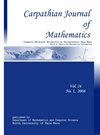{"title":"参数边界条件下(p,q,r)-拉普拉斯算子的特征值","authors":"L. Barbu, G. Moroşanu","doi":"10.37193/cjm.2022.03.03","DOIUrl":null,"url":null,"abstract":"\"Consider in a bounded domain $\\Omega \\subset \\mathbb{R}^N$, $N\\ge 2$, with smooth boundary $\\partial \\Omega$ the following nonlinear eigenvalue problem \\begin{equation*} \\left\\{\\begin{array}{l} -\\sum_{\\alpha \\in \\{ p,q,r\\}}\\rho_{\\alpha}\\Delta_{\\alpha}u=\\lambda a(x) \\mid u\\mid ^{r-2}u\\ \\ \\mbox{ in} ~ \\Omega,\\\\[1mm] \\big(\\sum_{\\alpha \\in \\{p,q,r\\}}\\rho_{\\alpha}\\mid \\nabla u\\mid ^{\\alpha-2}\\big)\\frac{\\partial u}{\\partial\\nu}=\\lambda b(x) \\mid u\\mid ^{r-2}u ~ \\mbox{ on} ~ \\partial \\Omega, \\end{array}\\right. \\end{equation*} where $p, q, r\\in (1, +\\infty),~q<p,~r\\not\\in \\{p, q\\};$ $\\rho_p, \\rho_q, \\rho_r$ are positive constants; $\\Delta_{\\alpha}$ is the usual $\\alpha$-Laplacian, i.e., $\\Delta_\\alpha u=\\, \\mbox{div} \\, (|\\nabla u|^{\\alpha-2}\\nabla u)$; $\\nu$ is the unit outward normal to $\\partial \\Omega$; $a\\in L^{\\infty}(\\Omega),$ $b\\in L^{\\infty}(\\partial\\Omega)$ {are given nonnegative functions satisfying} $\\int_\\Omega a~dx+\\int_{\\partial\\Omega} b~d\\sigma >0.$ Such a triple-phase problem is motivated by some models arising in mathematical physics. If $r \\not\\in (q, p),$ we determine a positive number $\\lambda_r$ such that the set of eigenvalues of the above problem is precisely $\\{ 0\\} \\cup (\\lambda_r, +\\infty )$. On the other hand, in the complementary case $r \\in (q, p)$ with $r < q(N-1)/(N-q)$ if $q<N$, we prove that there exist two positive constants $\\lambda_*<\\lambda^*$ such that any $\\lambda\\in \\{0\\}\\cup [\\lambda^*, \\infty)$ is an eigenvalue of the above problem, while the set $(-\\infty, 0)\\cup (0, \\lambda_*)$ contains no eigenvalue $\\lambda$ of the problem.\"","PeriodicalId":50711,"journal":{"name":"Carpathian Journal of Mathematics","volume":" ","pages":""},"PeriodicalIF":1.4000,"publicationDate":"2022-07-26","publicationTypes":"Journal Article","fieldsOfStudy":null,"isOpenAccess":false,"openAccessPdf":"","citationCount":"0","resultStr":"{\"title\":\"\\\"Eigenvalues of the (p, q, r)-Laplacian with a parametric boundary condition\\\"\",\"authors\":\"L. Barbu, G. Moroşanu\",\"doi\":\"10.37193/cjm.2022.03.03\",\"DOIUrl\":null,\"url\":null,\"abstract\":\"\\\"Consider in a bounded domain $\\\\Omega \\\\subset \\\\mathbb{R}^N$, $N\\\\ge 2$, with smooth boundary $\\\\partial \\\\Omega$ the following nonlinear eigenvalue problem \\\\begin{equation*} \\\\left\\\\{\\\\begin{array}{l} -\\\\sum_{\\\\alpha \\\\in \\\\{ p,q,r\\\\}}\\\\rho_{\\\\alpha}\\\\Delta_{\\\\alpha}u=\\\\lambda a(x) \\\\mid u\\\\mid ^{r-2}u\\\\ \\\\ \\\\mbox{ in} ~ \\\\Omega,\\\\\\\\[1mm] \\\\big(\\\\sum_{\\\\alpha \\\\in \\\\{p,q,r\\\\}}\\\\rho_{\\\\alpha}\\\\mid \\\\nabla u\\\\mid ^{\\\\alpha-2}\\\\big)\\\\frac{\\\\partial u}{\\\\partial\\\\nu}=\\\\lambda b(x) \\\\mid u\\\\mid ^{r-2}u ~ \\\\mbox{ on} ~ \\\\partial \\\\Omega, \\\\end{array}\\\\right. \\\\end{equation*} where $p, q, r\\\\in (1, +\\\\infty),~q<p,~r\\\\not\\\\in \\\\{p, q\\\\};$ $\\\\rho_p, \\\\rho_q, \\\\rho_r$ are positive constants; $\\\\Delta_{\\\\alpha}$ is the usual $\\\\alpha$-Laplacian, i.e., $\\\\Delta_\\\\alpha u=\\\\, \\\\mbox{div} \\\\, (|\\\\nabla u|^{\\\\alpha-2}\\\\nabla u)$; $\\\\nu$ is the unit outward normal to $\\\\partial \\\\Omega$; $a\\\\in L^{\\\\infty}(\\\\Omega),$ $b\\\\in L^{\\\\infty}(\\\\partial\\\\Omega)$ {are given nonnegative functions satisfying} $\\\\int_\\\\Omega a~dx+\\\\int_{\\\\partial\\\\Omega} b~d\\\\sigma >0.$ Such a triple-phase problem is motivated by some models arising in mathematical physics. If $r \\\\not\\\\in (q, p),$ we determine a positive number $\\\\lambda_r$ such that the set of eigenvalues of the above problem is precisely $\\\\{ 0\\\\} \\\\cup (\\\\lambda_r, +\\\\infty )$. On the other hand, in the complementary case $r \\\\in (q, p)$ with $r < q(N-1)/(N-q)$ if $q<N$, we prove that there exist two positive constants $\\\\lambda_*<\\\\lambda^*$ such that any $\\\\lambda\\\\in \\\\{0\\\\}\\\\cup [\\\\lambda^*, \\\\infty)$ is an eigenvalue of the above problem, while the set $(-\\\\infty, 0)\\\\cup (0, \\\\lambda_*)$ contains no eigenvalue $\\\\lambda$ of the problem.\\\"\",\"PeriodicalId\":50711,\"journal\":{\"name\":\"Carpathian Journal of Mathematics\",\"volume\":\" \",\"pages\":\"\"},\"PeriodicalIF\":1.4000,\"publicationDate\":\"2022-07-26\",\"publicationTypes\":\"Journal Article\",\"fieldsOfStudy\":null,\"isOpenAccess\":false,\"openAccessPdf\":\"\",\"citationCount\":\"0\",\"resultStr\":null,\"platform\":\"Semanticscholar\",\"paperid\":null,\"PeriodicalName\":\"Carpathian Journal of Mathematics\",\"FirstCategoryId\":\"100\",\"ListUrlMain\":\"https://doi.org/10.37193/cjm.2022.03.03\",\"RegionNum\":4,\"RegionCategory\":\"数学\",\"ArticlePicture\":[],\"TitleCN\":null,\"AbstractTextCN\":null,\"PMCID\":null,\"EPubDate\":\"\",\"PubModel\":\"\",\"JCR\":\"Q1\",\"JCRName\":\"MATHEMATICS\",\"Score\":null,\"Total\":0}","platform":"Semanticscholar","paperid":null,"PeriodicalName":"Carpathian Journal of Mathematics","FirstCategoryId":"100","ListUrlMain":"https://doi.org/10.37193/cjm.2022.03.03","RegionNum":4,"RegionCategory":"数学","ArticlePicture":[],"TitleCN":null,"AbstractTextCN":null,"PMCID":null,"EPubDate":"","PubModel":"","JCR":"Q1","JCRName":"MATHEMATICS","Score":null,"Total":0}
引用次数: 0


